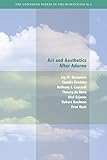Art and Aesthetics after Adorno / ed. by Robert Kaufman, Ales Erjavec, Thierry de Duve, Anthony J. Cascardi, Claudia Brodsky, J. M. Bernstein, Fred Rush.
Material type: TextSeries: Berkeley Forum in the HumanitiesPublisher: New York, NY : Fordham University Press, [2022]Copyright date: ©2013Description: 1 online resource (302 p.) : 3 Illustrations, black and whiteContent type:
TextSeries: Berkeley Forum in the HumanitiesPublisher: New York, NY : Fordham University Press, [2022]Copyright date: ©2013Description: 1 online resource (302 p.) : 3 Illustrations, black and whiteContent type: - 9780823253098
- 9780823290932
- online - DeGruyter
| Item type | Current library | Call number | URL | Status | Notes | Barcode | |
|---|---|---|---|---|---|---|---|
 eBook
eBook
|
Biblioteca "Angelicum" Pont. Univ. S.Tommaso d'Aquino Nuvola online | online - DeGruyter (Browse shelf(Opens below)) | Online access | Not for loan (Accesso limitato) | Accesso per gli utenti autorizzati / Access for authorized users | (dgr)9780823290932 |
Frontmatter -- Table of Contents -- Prolegomena to Any Future Aesthetics -- Adorno After Adorno -- Framing the Sensuous: Objecthood and “Objectivity” in Art After Adorno -- Poetry After “Poetry After Auschwitz” -- Aesthetics and the Aesthetic Today: After Adorno -- “The Demand for Ugliness”: Picasso’s Bodies -- Resisting Adorno, Revamping Kant -- Endnotes -- Contributors
restricted access online access with authorization star
http://purl.org/coar/access_right/c_16ec
Theodor Adorno’s Aesthetic Theory (1970) offers one of the most powerful and comprehensive critiques of art and of the discipline of aesthetics ever written. The work offers a deeply critical engagement with the history and philosophy of aesthetics and with the traditions of European art through the middle of the 20th century. It is coupled with ambitious claims about what aesthetic theory ought to be. But the cultural horizon of Adorno’s Aesthetic Theory was the world of high modernism, and much has happened since then both in theory and in practice. Adorno’s powerful vision of aesthetics calls for reconsideration in this light. Must his work be defended, updated, resisted, or simply left behind? This volume gathers new essays by leading philosophers, critics, and theorists writing in the wake of Adorno in order to address these questions. They hold in common a deep respect for the power of Adorno’s aesthetic critique and a concern for the future of aesthetic theory in response to recent developments in aesthetics and its contexts.
Mode of access: Internet via World Wide Web.
In English.
Description based on online resource; title from PDF title page (publisher's Web site, viewed 03. Jan 2023)


